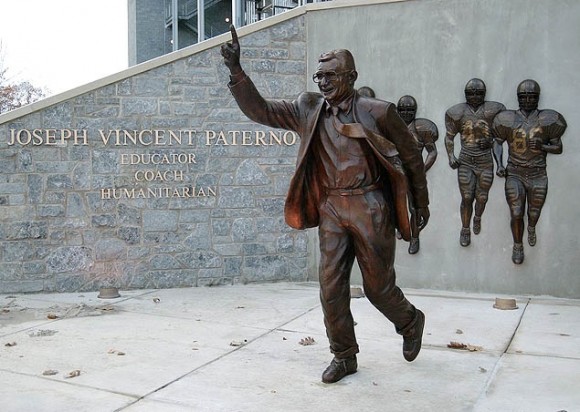Joe Paterno is known as one of the greatest college football coaches of all time. While his last few years of life was surrounded by negative publicity due to the scandal that engulfed the Penn State Football program and its participants, Joe Paterno will forever be recognized for his campus famous “409” wins. Joe Paterno is the winning most college football coach and will most likely remain as such for a long time. While coaching football was his passion, there was no lack of coaching for other aspects of his players lives. “Paterno wanted his team to play good football in the best league possible, with people who belong in college, and who kept things in perspective” (Maisel 2011). Joe Paterno is a strong example of the supportive leadership style which is identified by the Path-goal theory.
The Path-goal Theory identifies four different leadership styles which are employed by a leader given a situation (Seyranian, 2012, p. 2). The four leadership behaviors include supportive, directive, achievement oriented, and participative (Seyranian, 2012, p. 2). While Joe Pa might utilize each of these behaviors given a specific situation, his supportive behavior is a leading leadership style which made him such a great leader. The supportive leadership behavior focuses on the relationship with the follower which allows the leader to motivate his/her followers to achieve a specific task or designated goals (Seyranian, 2012, p. 2).
Joe Pa not only showed these tendencies when coaching his players in football practice, but he is known for guiding his players through school and making sure his followers were not simply relentless athletes but also dedicated students. “The NCAA reported that Penn State football players graduated at a rate of 74 percent, 19 points above the national average” (Maisel 2011). Joe Pa had a different relationship with each of his players and was available for help, coaching, and guidance for each of them. “Joe Paterno devoted his entire career to a belief in the power of athletics, but only when coupled with the power of academics” (Maisel 2011).
Based on Path-goal Theory, Joe Paterno would likely be classified as having utilized supportive leadership behaviors to build the strong relationships he had with Penn State, the respect he has as a coach, and the love he had from the Penn State community. It was Joe Pa’s influence and investment in each of his students lives which made him such an amazing coach.
References
Maisel, I. (2011, November 9). Joe Paterno’s Penn State legacy. ESPN. Retrieved June 7, 2014, from http://espn.go.com/college-football/story/_/id/7212678/penn-state-nittany-lions-coach-joe-paterno-legacy
Seyranian, V. (2012, January 30). “Encyclopedia of Group Processes and Intergroup Relations”. SAGE Reference Online. http://www.sagepub.com/northouse6e/study/materials/reference/reference6.1.pdf


I really enjoyed reading your blog post about Penn State’s famous football Coach, Joe Paterno. I think he positively influenced the lives of many people who became professionals in a wide range of organizations. Joe Paterno was undeniably a great leader and reading your comments relating to the Path-Goal theory established in the early 1970’s you seem to relate his leadership to a supportive leadership style. This style is one where leaders go out of their way to make work enjoyable for their subordinates.
Although there may have been times where Coach Paterno was interested in making life enjoyable for his team, I don’t seem him solely as a supportive leader within the framework of this theory. I would argue that, in terms of the Path-Goal theory Coach Paterno mainly exhibited Achievement-oriented Leadership. Achievement-oriented leadership is a type of leadership that challenges subordinates to perform at the highest level possible (The Pennsylvania State University, 2014). This type of leadership shows a great deal of confidence in the leaders’ subordinates, something the Penn State University football team always demonstrated when they rushed onto the field.
Although this theory says that leaders can use one or more of the leadership styles (Directive, Supportive, Participative and Achievement-Oriented) Coach Paterno’s demand for performance was certainty along the lines of House and Mitchell’s Achievement- oriented style. I’m very curious to hear your thoughts on this leadership style and the legendary Coach Paterno.
References
Northouse, P.G. (2013). Leadership: Theory and Practice. Los Angeles: Sage Publications.
The Pennsylvania State University. (2014). Lesson 6, Part 2: Path-Goal Theory. Retrieved online from Psych 485: Leadership in Work Settings. at: https://courses.worldcampus.psu.edu/su14/psych485/001/content/06_lesson/04_topic/03_page.html
Excellent example of Path Goal theory applied to a great leader. I remember during the negative time, everyone rallied around him within the community even though the nation was on a head hunt. His style of leadership was amazing as ESPN always gave Joe Pa high respects during his coaching tenure and always giving kudos to all his off the field support. His leadership style was true because you knew he didn’t put on a front, he believed every bit of what he did and it had a positive purpose. You could also say he was a transformational leader as well.